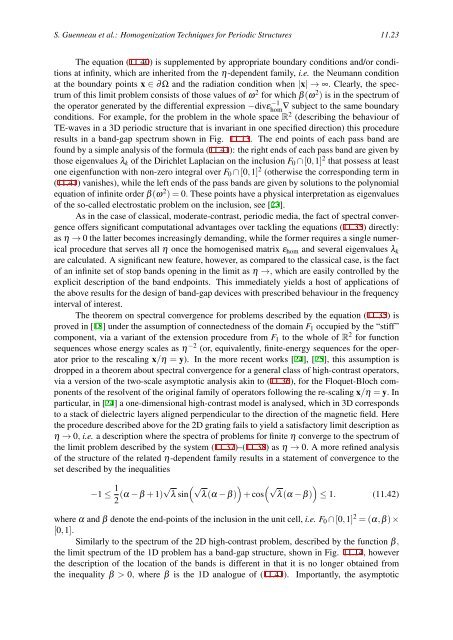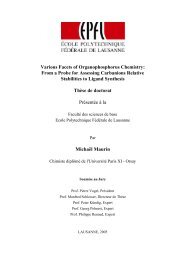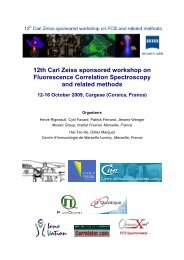GratinGs: theory and numeric applications - Institut Fresnel
GratinGs: theory and numeric applications - Institut Fresnel
GratinGs: theory and numeric applications - Institut Fresnel
You also want an ePaper? Increase the reach of your titles
YUMPU automatically turns print PDFs into web optimized ePapers that Google loves.
S. Guenneau et al.: Homogenization Techniques for Periodic Structures 11.23<br />
The equation (11.40) is supplemented by appropriate boundary conditions <strong>and</strong>/or conditions<br />
at infinity, which are inherited from the η-dependent family, i.e. the Neumann condition<br />
at the boundary points x ∈ ∂Ω <strong>and</strong> the radiation condition when |x| → ∞. Clearly, the spectrum<br />
of this limit problem consists of those values of ω2 for which β(ω 2 ) is in the spectrum of<br />
the operator generated by the differential expression −divε −1<br />
hom∇ subject to the same boundary<br />
conditions. For example, for the problem in the whole space R2 (describing the behaviour of<br />
TE-waves in a 3D periodic structure that is invariant in one specified direction) this procedure<br />
results in a b<strong>and</strong>-gap spectrum shown in Fig. 11.13. The end points of each pass b<strong>and</strong> are<br />
found by a simple analysis of the formula (11.41): the right ends of each pass b<strong>and</strong> are given by<br />
those eigenvalues λk of the Dirichlet Laplacian on the inclusion F0 ∩ [0,1] 2 that possess at least<br />
one eigenfunction with non-zero integral over F0 ∩ [0,1] 2 (otherwise the corresponding term in<br />
(11.41) vanishes), while the left ends of the pass b<strong>and</strong>s are given by solutions to the polynomial<br />
equation of infinite order β(ω 2 ) = 0. These points have a physical interpretation as eigenvalues<br />
of the so-called electrostatic problem on the inclusion, see [23].<br />
As in the case of classical, moderate-contrast, periodic media, the fact of spectral convergence<br />
offers significant computational advantages over tackling the equations (11.35) directly:<br />
as η → 0 the latter becomes increasingly dem<strong>and</strong>ing, while the former requires a single <strong>numeric</strong>al<br />
procedure that serves all η once the homogenised matrix εhom <strong>and</strong> several eigenvalues λk<br />
are calculated. A significant new feature, however, as compared to the classical case, is the fact<br />
of an infinite set of stop b<strong>and</strong>s opening in the limit as η →, which are easily controlled by the<br />
explicit description of the b<strong>and</strong> endpoints. This immediately yields a host of <strong>applications</strong> of<br />
the above results for the design of b<strong>and</strong>-gap devices with prescribed behaviour in the frequency<br />
interval of interest.<br />
The theorem on spectral convergence for problems described by the equation (11.35) is<br />
proved in [18] under the assumption of connectedness of the domain F1 occupied by the “stiff”<br />
component, via a variant of the extension procedure from F1 to the whole of R2 for function<br />
sequences whose energy scales as η−2 (or, equivalently, finite-energy sequences for the operator<br />
prior to the rescaling x/η = y). In the more recent works [24], [25], this assumption is<br />
dropped in a theorem about spectral convergence for a general class of high-contrast operators,<br />
via a version of the two-scale asymptotic analysis akin to (11.36), for the Floquet-Bloch components<br />
of the resolvent of the original family of operators following the re-scaling x/η = y. In<br />
particular, in [24] a one-dimensional high-contrast model is analysed, which in 3D corresponds<br />
to a stack of dielectric layers aligned perpendicular to the direction of the magnetic field. Here<br />
the procedure described above for the 2D grating fails to yield a satisfactory limit description as<br />
η → 0, i.e. a description where the spectra of problems for finite η converge to the spectrum of<br />
the limit problem described by the system (11.37)–(11.38) as η → 0. A more refined analysis<br />
of the structure of the related η-dependent family results in a statement of convergence to the<br />
set described by the inequalities<br />
−1 ≤ 1<br />
2 (α − β + 1)√ (√ ) (√ )<br />
λ sin λ(α − β) + cos λ(α − β) ≤ 1. (11.42)<br />
where α <strong>and</strong> β denote the end-points of the inclusion in the unit cell, i.e. F0 ∩[0,1] 2 = (α,β)×<br />
[0,1].<br />
Similarly to the spectrum of the 2D high-contrast problem, described by the function β,<br />
the limit spectrum of the 1D problem has a b<strong>and</strong>-gap structure, shown in Fig. 11.14, however<br />
the description of the location of the b<strong>and</strong>s is different in that it is no longer obtained from<br />
the inequality β > 0, where β is the 1D analogue of (11.41). Importantly, the asymptotic













